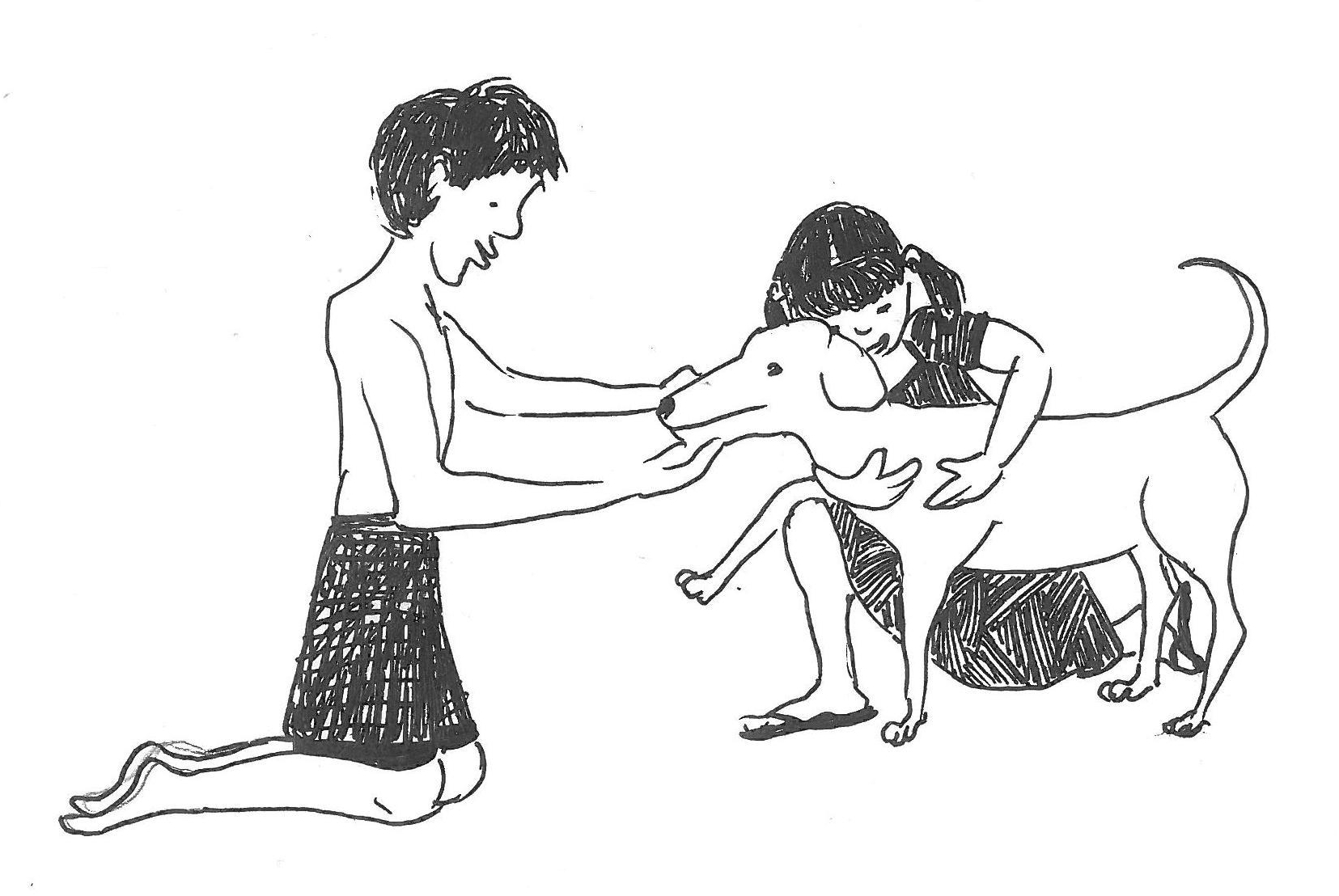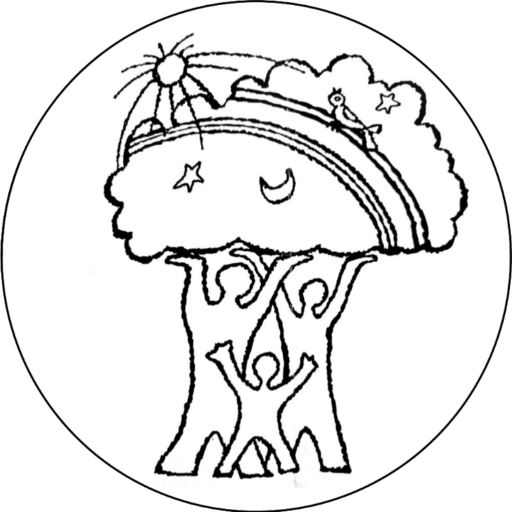We would like to share our experiences, joy of being and learning from nature from Marudam farm school where both of us have been working and living with children and with nature for a while.
A sentence from the book ‘where the wild things are’ comes to mind – “a forest grew and grew… and became the world all around”
Nature is the world all around for children. It’s all encompassing. It’s everywhere.
Small children love being outdoors. They need to be out and about. It orients them, grounds them, teaches them relationships, connections, the scale of things and gives a rich sensory feedback.
Children perceive nature from the ground up. Because the ground is that much closer to them – or them to the ground – that’s their most immediate impression. The picture of a toddler crouching on the ground for endless moments, intensely following an ant or inspecting a dry leaf comes to mind.
It is said that the first sense that humans develop is the sense of touch, in many ways it is that sense which governs their nature experience – touching the soil, picking rocks, playing in sand, the feel of wind and sun on their face, the wetness of water… Of course senses of smell and taste follow closely and are very strong, which explains the irresistible urge to put things in the mouth, an exploration in its own right.
This is not to say that children don’t perceive nature through sight and hearing, but we feel that the way they perceive through touch is broader than that. The senses are used more equally and together than is the case with older people.
As children grow and learn to move about more efficiently – from being immobile, to crawling, to sitting, to standing, to walking, to jumping, to running, to climbing – their perception of nature broadens. They are able to explore further, with nature providing the playground in which to practice and develop all their new moves. The sense of where your body is in space, called proprioception, is then often at the centre of the child’s perception of nature.
At age 5 to7, they begin to become more conscious of the difference between themselves as ‘humans’ and other elements of nature. They move from a purely sensory mode of interaction to a curious, inquiring mode, which we see in the way they begin to make and articulate detailed observations at this age.
They will look for patterns in insects, and ask questions about birds, and will have a vast amount of curiosity about any element that interests them.
It is at this age that it is critical for us (as a parent or an educator) to hone that curiosity without stifling the spontaneity of the child. The capacity and ability to engage with new experiences and make meaning from it is phenomenal at this age, and nature offers unlimited opportunities to utilize this capacity. For example, when we go into the forest with the children, every aspect of the forest fascinates them. They get to different textures, thorns, slush, dry leaves etc. They get to understand different concepts, like camouflage and diversity, temperature and so on. As with the young of any species in the forest, every moment they are facing something new, and trying to understand it. And just like all young creatures, they learn a lot by observing the behavior of the adults around them.
Children are naturally alert. So they are able to observe things in detail. In their excitement and curiosity they rush to explore more, such as reaching out to touch any plant or animal that excites them, plucking flowers, reaching out to birds’ nests, going after a snake and so on. At the same time, children are ready to become aware that they are sharing the space with other beings of the environment. This provides us an opportunity to explain the need for silent observation and for respecting all creatures and the spaces we share.
The educator’s role at this age is crucial to help children grow into caring, empathetic students of nature, without curbing their enthusiasm or spontaneity. By doing this, we can harness their natural curiosity, and extend observation into study by encouraging attention to detail. For example, a 6-year old engaged in studying ants noticed how they were moving homes and taking food from one point to another, and guessed that this was because the rains were about to come. Another child studied the praying mantis and came back to class exclaiming at how different it looked from images she had seen. When presented with a ‘formal’ book with real diagrams [ostensibly meant for older children], she was satisfied. This example also reminds us that children don’t need to be spoken down to, when they are engaged in study borne of their own curiosity, they will learn to make meaning from whatever material is given to them – therefore we need to be responsible and give them accurate, sensible resources.
In the age group 8 to 10, this engagement with nature develops further, aided by the greater understanding of the world the children are starting to develop. They start to understand that they are part of a food chain, and their experience of nature is altered by this realization. They start considering the concept of interdependence among species. By observing a farm ecosystem, or a pond, or a forest, they will start to develop food webs, which will help them understand these dependencies in terms of producer, consumer, and decomposer relationships. At this age, they can infer and interpret their observations, and will engage in a higher degree of questioning. For example, while observing a pond ecosystem, their questions won’t be limited to purely what they see, but will start envisioning hypothetical situations also – what will happen when the pond dries? How does life come back when it rains and the pond fills up?
At the ages 10-12, they are able to start formalizing their knowledge – The study of ecosystems, and the further realization that some beings are ecosystems unto themselves [a fig tree supporting 100s of species] generates a first concrete understanding and appreciation of concepts like adaptation, reproduction, migrations, ecological niche and so on.
They can engage with classification, categorization and taxonomy at their own level, as per their own understanding and observation. For instance, a 10-year old child can be given a group of assorted seeds and asked to categorize them. Their categorization may not match a formal framework, and each child may have a different approach, but it will have an internal logic based on their experiences.
At around 12 or 13 their engagement with nature starts to take on a more ‘adult’ form. Building from the characteristics mentioned above, they can also start to clearly see human participation as different and more damaging from the rest of the creatures in nature. Now the children are ready to understand the concept of evolution. They begin to perceive our destructive interaction with nature.
This kind of an understanding leads up to a more personal relationship with nature – one which features empathy and responsibility as much as excitement and curiosity. This takes many forms, for example the relationships with pets and houseplants for urban children, and many more aspects for children living closer to nature. Even the simple facts of one’s surroundings that have always been considered ‘normal’ start taking on a greater significance – the cockroaches and lizards and ants that have always lived in our houses are no longer just creatures that we share space with, they are now a part of our own local ecosystem. There is an understanding of privilege, of the gravity of being a part of this system, something that has in the past been experienced with less intensity, less conscious thought.
Another aspect of this same growth is that sensorial experiences start being perceived differently – it goes a level deeper, affecting at an emotional level. Your enjoyment of a phenomenon, for instance, can be removed from participation. We observe that younger children’s experience of rain may be joyful because they love to play in the rain, whereas an older child can look at the rain, see children playing in the rain, and enjoy these aspects internally while understanding the importance and significance of life support that rain provides. They start to express their connection with nature in the form of poetry. Their connection with nature deepens here and the child is fully ready to understand the concept of ecology and nature conservation.

This process is continuous, and requires support and encouragement from the children’s parents or guardians. It is important that we provide that access to nature and animals as much as possible – whatever be the context. Even urban parents have plenty of opportunities – walks in parks and along nearby water bodies for example. If possible, adopting a pet is a wonderful learning experience, but even if that isn’t possible take walks with and feed stray dogs, observe animals within the home. This could be backed up with some basic equipment [a small magnifying glass, a diary in which to note or sketch observations, paste cuttings etc.] as well as a space they can call their own – where they can keep their ‘collections’ and so on. Small actions like having a bird feeder and some plants around the house go a long way in providing the child with material to learn from and engage with. We can learn more by observing small insects and other creatures instead of killing them for no reason.
Keeping the natural fascination of the child alive is most important. It is a wonderful journey for every child to engage with nature, and when supported by the people around them it has the potential to result in some of the most meaningful relationships of their lives.

Leela Arnon-Bowley is from Israel and has been living in Thiruvannamalai, Tamil Nadu, with her husband and 2 children for the past 17 years. She has been involved in ‘The Forest Way’ and ‘Marudam farm school’ since inception.

Poornima – Activist, Teacher. Founder/Principal of Marudam school since 2009. Before that she worked with a school for underprivileged children in Chennai as a teacher for 13 years and with street children in Bombay for 4 years. She has also been engaging with teachers through workshops.
